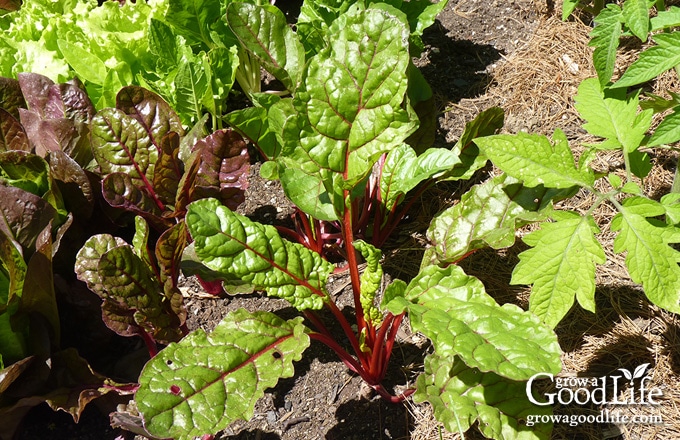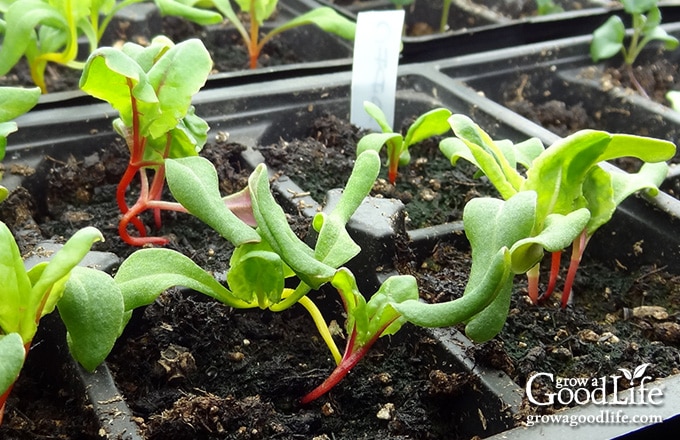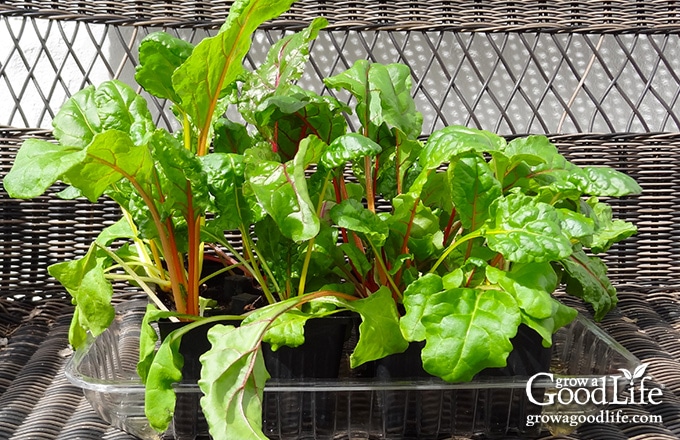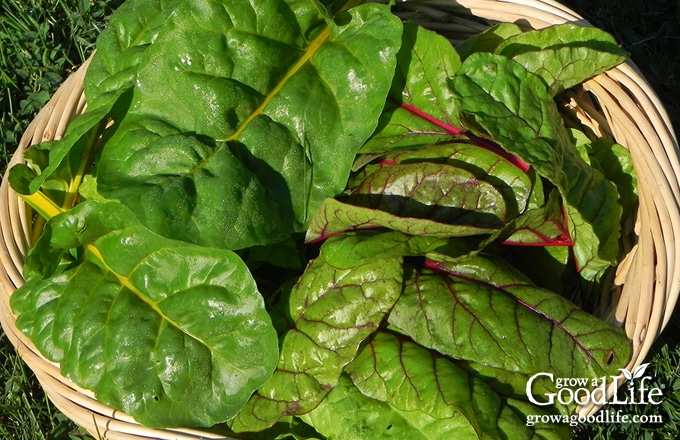How to Grow Swiss Chard
This post may contain affiliate links, which means that I may receive a commission if you make a purchase using these links. As an Amazon Associate I earn from qualifying purchases.
Swiss chard is a leafy green vegetable that can be grown in a variety of climates and soils. It is easy to grow, making it an ideal vegetable if you want to enjoy abundant harvests of fresh greens year-round. Learn how to grow Swiss chard so you can enjoy plenty of harvests throughout the gardening season.

Swiss chard can be eaten raw in salads, cooked like kale and spinach, and used in soups, stews, and pasta dishes. The plants are more tolerant to heat than other cool-season greens, making it a good crop to grow all season long. When spring spinach bolts as the summer heat arrives, Swiss chard can take its place in recipes.
Chard is easy to grow from seed and can grow in containers or in a vegetable garden. It’s also an ideal plant to grow indoors during winter and as microgreens.
It is such an attractive plant, with its colorful stems and bold green leaves, that it will blend in well as an ornamental among your flowers. Any way you decide to grow Swiss chard, it is a nutritious plant that earns its spot in your garden.
About Swiss Chard
This leafy green vegetable, also known as silverbeet, was identified and named by a Swiss botanist. That’s why it has “Swiss” in the common plant name. The scientific name for the plant is Beta vulgaris subsp. cicla, and the plant is often called “chard” for short.
Chard is a member of the beet family, even though it does not develop a bulbous root. Swiss chard, beets, and spinach are also members of the goosefoot family because the plant leaves are shaped like a goose’s foot.
The stems come in a wide array of colors, including red, pink, yellow, orange, and white, and can be chopped and added to recipes like celery.
Swiss chard is considered one of the top superfoods and a nutritional powerhouse ideal for adding to any diet. It is naturally low in calories, high in fiber, magnesium, potassium, iron, and rich in vitamins A, C, and K.
Swiss Chard Varieties to Consider
Swiss chard is known for its shiny green leaves and brightly colored stems. While colored chard is attractive in the garden and on the plate, the white stem varieties are generally more productive, cold tolerant, and bolt resistant. Here are some common types of Swiss chard to consider growing:
- Fordhook Giant Chard has dark green crinkly leaves and white stalks and veins. Give these plants plenty of room, and they will vigorously produce broad leaves throughout the growing season. Matures in 50 days and will tolerate heat better than other varieties.
- Lucullus Swiss Chard produces an abundance of broad, light green, wrinkled leaves with white ribs on top of ivory-colored celery-like stalks. The plants mature in 70 days and can reach 2 feet tall.
- Multi-Colored Chard is a mix of different varieties that produce green leaves and an assortment of colored stalks in gold, pink, orange, red, and white. Colored stem varieties are slightly less frost-hardy than others. Types of mixed colored chard include bright lights, celebration, five-colored silverbeet, and rainbow blend chard.
- Ruby Red Chard is also called rhubarb chard due to its dark green leaves and red stems that resemble a miniature rhubarb plant. This variety grows reddish-tinged dark green wrinkled foliage with red veins and stalks. Young plants are more sensitive to cold than other varieties and may bolt or go to seed if exposed to nighttime temperatures below 50˚F.
- Silverado Chard is a more compact plant with glossy, deep green crinkled leaves and short, narrow white stems. The plants grow more slowly than other varieties but are extremely bolt resistant and will continue to produce harvests all season. Silverado can also withstand cold temperatures better than the colored chard varieties.
- Sunset Chard features large green leaves and bright yellow to orange stems and veins. The plants tolerate frost and heat very well for a colored variety and will be ready to harvest as baby green in 30 days or full-sized in 60 days.

Tips for Growing Swiss Chard
Swiss chard is a cool-weather vegetable that is easy to grow and thrives when given the right conditions. The plant grows best in moist, well-draining, fertile soil, with a pH between 6.0 and 6.8, but can also be grown in poor soil with adequate water and fertilizer. The plants prefer full sun but will tolerate part sun or light shade. Here are a few tips for growing Swiss chard:
When to Grow Chard
Chard is a cool-season vegetable that grows best in spring and fall. The time to start seeds is based on your area’s last estimated frost date. You can find your last frost date by contacting your local extension office (search for “extension office near me”) or enter your zip code here at PlantMaps.com.
In northern climates, direct sow seeds in early spring after the danger of heavy frost is past. Or start chard seeds indoors 4 weeks before your last spring frost date, and transplant hardened-off seedlings to the garden several weeks after your last frost date. Learn How to Make a Seed Starting and Planting Schedule.
To lengthen harvests into late spring and summer, grow Swiss chard in an area that will provide the plants with morning sun and afternoon shade, giving them ample sunlight to develop while keeping them cool enough to prevent bolting.
You can also succession sow to extend your harvests. Sow another round of seeds every two weeks for fresh plants. Take a break during the hottest time in summer, and then begin sowing again in late summer for a fall crop. Learn more about succession sowing in this article: 3 Succession Sowing Tips to Extend Your Harvests.
Planting Swiss Chard
Chard grows best in the cool temperatures of spring and fall. However, it is one of the few plants that can grow well in partial shade, and mature plants tolerate warmer temperatures.
Chard will thrive in direct sunlight in early spring or fall since the sun is less intense during those times of the year. However, the plants will appreciate a little shade in the afternoon as the weather gets warmer and the sun is more powerful.
You can start Swiss chard seeds indoors under grow lights, purchase transplants at a garden nursery, or direct sow seeds in the garden.
Starting Seeds Indoors
Starting seeds indoors under lights will provide you with an earlier harvest. Sow seeds indoors about 4 to 6 weeks before your last frost date.
Swiss chard seeds are actually a seedpod that contains several seeds. You can soak the pod for 24 hours before planting them to soften the hard outer shell.
Fill your containers with damp seed starting mix to within 1/2-inch of the top of the container. Poke a hole about 1/2-inch deep, drop in a seed cluster, and then cover with a soil mix. Just one seed cluster is needed. Swiss chard seeds have a very high germination rate, and you can expect 95% germination.
Gently moisten the soil by spraying it with water from a spray bottle, and cover the containers with a humidity dome to keep in moisture. Use a spray bottle to keep the soil moist so you won’t dislodge the seeds during germination.
Chard seeds germinate best in temperatures between 50˚F to 85˚F, and you should seed sprouts within 7 to 12 days. Once the seeds sprout, place the plants under grow lights or in indirect lighting from a window, and continue to keep the soil moist. Then, harden off your seedlings and transplant them into the outdoor garden after the soil has warmed to 50˚F and the seedlings are 3 to 4 inches tall. You can learn more about starting seeds indoors in this article: 10 Steps to Starting Seeds Indoors.

How to Prepare the Garden Bed
Prepare the garden bed as soon as you can work the soil in early spring by cleaning up plant debris and weeds. Next, add about 2 inches of finished compost, and work it in about 6 to 8 inches deep. The compost will help keep the plants fed, prevent soil compaction, and promote good drainage and airflow. Plus the compost will attract earthworms that will be beneficial to the garden soil. If the weather has been dry, prepare and water the bed well the day before you sow seeds or transplant seedlings.
Transplanting Seedlings
If you start seeds indoors or purchase transplants from a warm greenhouse, they should be hardened off before transplanting. The hardening-off period helps your plants adapt to the sun, wind, and chilly nights they will experience in the garden. Learn How to Harden Off Seedlings with this step-by-step tutorial.

After your seedlings are hardened off, you can transplant them into their permanent location in the garden. Choose a cloudy day with no wind and transplant in the late afternoon or evening to give your plants time to adjust without the additional challenge of the sun.
Dig your holes about 6 to 8 inches apart. Carefully remove the seedlings from the container, place them in the holes, and gently firm the soil around the plants. Water well after planting, and keep the soil damp until the plants become established.
Direct Sowing Seeds
Swiss chard seeds can be sowed outdoors in the garden in early spring once the soil temperature exceeds 40˚F. The seeds will germinate best in temperatures between 50˚F to 85˚F and should sprout within 7 to 12 days.
Prepare the garden ahead of time, and sow your seeds in shallow, damp soil, about 1/2-inch deep. Space the seeds 2 to 3 inches apart and cover them with soil. Firm the soil gently and water in well. Learn more about direct sowing seeds with this article: How to Direct Sow Seeds.
How to Care for Chard Plants
Swiss chard plants are easy to care for and, other than watering, thinning, and weeding, are pretty trouble-free. Here are some tips to keep your plants healthy and thriving.
Watering
Swiss chard plants love moisture and will continue producing new leaves as long as the plant receives regular watering. The plants need about 1-inch of water per week from rain or hand watering. The leaves will turn bitter if the plant doesn’t get enough water.
Check the soil moisture by poking your finger several inches deep. If the soil is dry, give your chard a good watering. Apply the water directly to the soil around the plants, and avoid wetting the leaves to help prevent fungal diseases.
Thinning the Plants
Since the seeds are clustered in a seedpod, you will likely get several plants sprouting from one seed. These will need thinning as they grow.
Once the plants are around 5-inches high, thin so each seedling is spaced 6 to 8-inches apart. Use scissors to cut the unwanted plants at the soil level to avoid disturbing the roots. The thinned plants are perfect for eating raw in a salad or adding to a stir-fry recipe.
Weeding and Mulching
Weed around your chard plants by hand, and then add a generous layer of organic mulch around the plants to keep the soil cool and retain moisture. The mulch will also help prevent weed growth. Keep the mulch several inches away from the plants.

Fertilizing
If you worked in a good amount of compost when you prepared the garden beds for planting, you might not need to add any additional fertilizer. However, if your plants are struggling, give them a boost by watering them with organic liquid fertilizer, such as fish emulsion or compost tea. Apply to the ground at the base of the plants, and avoid wetting the leaves.
Additionally, you can nourish your plants with an organic nitrogen fertilizer throughout the growing season. Nitrogen will help produce healthy green growth. Side dress the plants with composted chicken or poultry manure, or use an organic nitrogen fertilizer such as blood meal or feather meal.
Extending the Harvest
Swiss chard seedlings that are sufficiently hardened off will survive light frosts, and mature plants can tolerate freezing temperatures as low as 20˚F.
Even so, you can extend the harvests well into winter by providing some protection from the cold. Try growing Swiss chard in a cold frame, hoop house, or grow tunnel. You can use 10-foot pieces of PVC to make hoops over a raised bed and drape with 5-mil painter’s plastic for some cold protection. You can see more ideas in this article on How to Protect Your Plants from Frost.
Pests and Diseases
Few pests bother Swiss chard, but some you may face are aphids, caterpillars, flea beetles, leaf miners, slugs, and snails. Most are not a big problem and won’t kill the plant, but they may ruin some of the foliage. You can use row covers to prevent the pests from finding your plants. If you do see signs of damage, remove the affected leaves.
- Aphids are small insects that congregate in clusters on the leaves of your plants. They are sap-sucking insects, meaning they suck out the nutrients from your plant, causing the leaves to look wilted. You can easily dislodge aphids from your plants by hosing them down with a jet stream of cool water.
- Caterpillars and worms come from butterflies and moths laying eggs on the foliage. After hatching, the caterpillars feed on the chard until they form a cocoon. Handpick frequently and toss in a jar of soapy water, and use row covers to prevent the moths from laying eggs.
- Leaf Miners are the larvae of small flies that lay eggs within the leaves. Once hatched, the larvae feed in between the plant tissue, leaving behind a tunnel of dead material. Remove and destroy the affected leaves.
- Slugs and Snails love to turn your greens into their dinner. Luckily, there are some very effective methods of controlling them. Putting down a layer of crushed eggshells is extremely helpful in deterring these pests from reaching your plants. You can also handpick them off your plants and toss them out of the garden.
Some fungal diseases, such as powdery mildew, downy mildew, and leaf spot, can take hold under humid conditions, wet foliage, and a lack of air circulation. To help prevent fungal diseases, improve airflow by adequately spacing the plants and growing in full sun to partial shade. Mulch and water close to the base of the plant to reduce the risk of wet foliage, and remove foliage that is damaged or shows signs of mildew.
Growing Swiss Chard in Containers
Swiss chard’s upright shape and shallow root system make it an ideal crop to grow in pots. However, the plants get top-heavy, so choose medium-sized containers at least 6 to 8-inches deep and hold at least 2 to 3 gallons of soil to help anchor the pot and prevent it from tipping over.
Use a good-quality potting mix suitable for growing vegetables in containers. Mix in a balanced slow-release organic fertilizer, and then hydrate the soil by letting it soak for several hours. Fill the pot once the soil is evenly damp.
Transplant seedlings or direct sow the seeds in the pot and water well. Keep the soil evenly moist until the plants become established. Then let the soil dry out slightly between waterings, watering when the top inch is dry. Thin and harvest the outer leaves as needed for meals. You can learn more about growing edibles in pots in the following article: How to Grow Vegetables in Containers
How to Grow Chard Indoors
Swiss chard will grow indoors year-round with some supplemental lighting. Swiss chard plants are colorful and just as attractive as houseplants, especially when growing them in winter. Since it is a cool season crop, it will grow very well on a south-facing windowsill that may get chilly at night.
Choose pots about 6 to 8-inches deep, and fill them with a damp potting mix suitable for containers. Mix in a balanced slow-release organic fertilizer, and sow your seeds or plant seedlings. Water regularly, thin, and harvest as needed. Learn more about growing food indoors: How to Grow Vegetables Indoors
Harvesting Swiss Chard
You can harvest Swiss chard at any stage, from baby greens to full-sized leaves. However, it is best to gather in the morning, while it is still cool, once the dew has evaporated from the foliage.
Baby greens are ready to harvest in about 45 days or once the young leaves are about 3-inches tall. To harvest, snip leaves from the outside of the plant, and it will grow more foliage from the center.
Mature leaves are ready to harvest in 50 to 60 days or when they are between 9 to 12 inches high. Harvest the outer leaves first to allow the tender inner leaves to continue growing and producing more foliage.
Harvest tender leaves frequently using scissors to snip the stem at the base of the plant. The longer the leaves mature, the more likely they will become tough and bitter. If this happens, snip off the older leaves, and allow the plant to continue to produce fresh foliage.

Enjoy the stalks and leaves raw or cooked. Toss the greens into salads, sauté with olive oil and garlic, use as a wrap for sandwiches, or stuffed and baked in the oven. The stems can be chopped and added to salads, braised like asparagus, or cooked into various soups and stir-fried dishes.
To store freshly harvested Swiss chard, wash well under running water, air dry, and store in plastic zipper bags in your refrigerator crisper drawer. Adding a paper towel to the bag will absorb extra moisture and help keep your chard fresh. Swiss chard should last about two weeks in the refrigerator.
—
Swiss chard is a versatile vegetable that you can use in various dishes. I hope this article helps you see how easy it is to grow and how beneficial it can be to have a continuous harvest of this healthy green. So why not give Swiss chard a try in your garden this year?
You May Also Like the Following:
- How to Make a Seed Starting and Planting Schedule
- Over 30 Crops to Grow in Shady Spots
- How to Grow Lettuce
Good planning is key to a successful vegetable garden
Whether you are new to growing your own food or have been growing a vegetable garden for years, you will benefit from some planning each year. You will find everything you need to organize and plan your vegetable garden in my PDF eBook, Grow a Good Life Guide to Planning Your Vegetable Garden.

